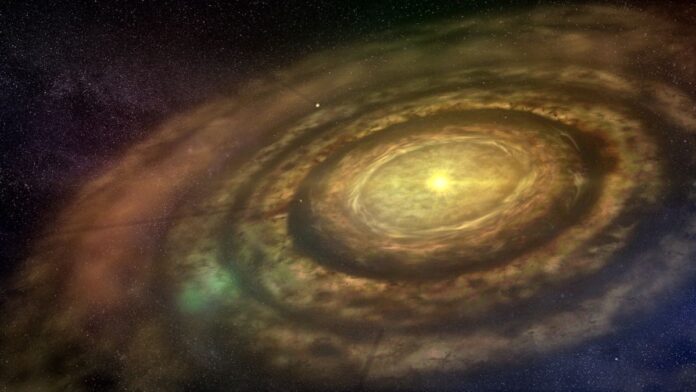Observations of a distant red dwarf star indicate that it is surrounded by not one but two massive rings of gas and dust, with tantalizing hints that it is orbited by a Saturn-size planet.
The red dwarf, known as 2MASS J04124068+2438157, is located around 485 light-years from Earth and has a diameter similar to that of the sun, but with a mass less than half that of our star. The red dwarf is also a virtual infant in comparison to the nearly 4.6 billion-year-old sun; it’s estimated to be just 4.7 million years old.
Prior observations of 2MASS J04124068+2438157 revealed that the star may be surrounded by an extended disk of dust. This prompted a team of astronomers led by Feng Long of the University of Arizona to observe the star with the Atacama Large Millimeter/Submillimeter Array (ALMA), a network of 66 radio telescopes in the Atacama Desert of northern Chile.
Related: Amazing photos from the ALMA radio telescope
The team hoped to better understand the disk looping around the dwarf star, but what they actually uncovered was the presence of two separate structures: The red dwarf’s dust disk is made up of two rings, one around 6.5 billion miles (10.5 billion kilometers) from the star and the other around 10 billion miles (16 billion km) away.
The researchers think that the gap in the dust disk may have been created by a Saturn-size planet orbiting 2MASS J04124068+2438157 at a distance of about 8.4 billion miles (13.5 billion km). That’s around 90 times the distance between Earth and the sun and 10 times the distance between Saturn and our star.
Both dust rings are quite narrow for such structures, with the closer one to the red dwarf having a width of around 520,000 miles (840,000 km) and the farther one having a thickness of 790,000 miles (1.27 million km). The size of the entire dust disk is about 11.7 billion miles (18.8 billion km), which is much larger than other disks with similar brightness, the researchers said.
The team believes that the large size of this disk indicates that it was massive when it formed. They further speculate that a pressure bump arose in the outer ring early in the disk’s history, which led to the trapping of dust particles. This allowed millimeter-sized grains to be sustained at large distances from the red dwarf.
The team’s assumption of a Saturn-size exoplanet around the red dwarf star still needs to be confirmed. The researchers hope to use NASA’s James Webb Space Telescope to hunt for the planet in the star’s outer disk.
The team’s research, which has not yet been peer-reviewed, was published on the online paper repository ArXiv (opens in new tab).
Follow us on Twitter @Spacedotcom (opens in new tab) or on Facebook (opens in new tab).

